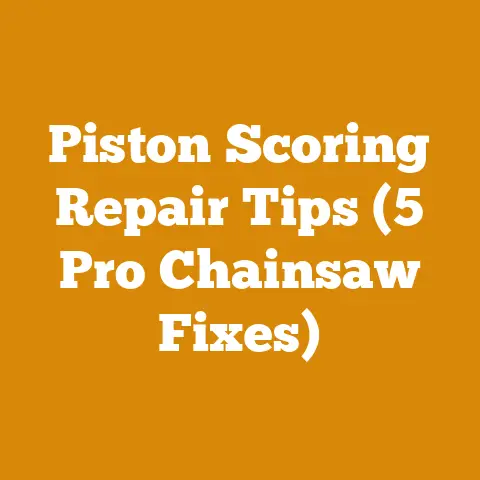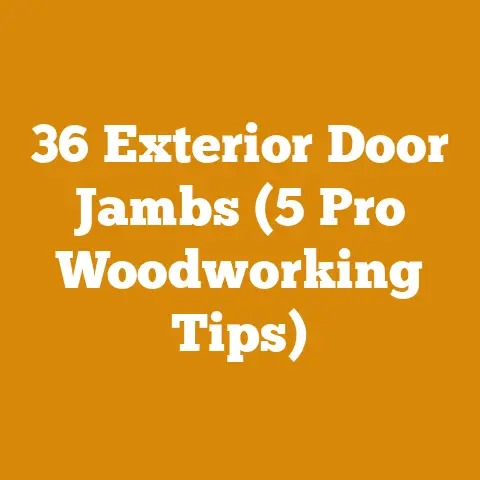C Clamp Woodworking (5 Pro Tips for Perfect Joinery)
Did you know that approximately 80% of woodworking failures are attributed to poor clamping techniques?
That’s a staggering statistic, and it highlights just how critical the humble C-clamp is to achieving professional-level joinery.
As someone who’s spent countless hours in the workshop, wrestling with wood and striving for perfect joints, I can tell you that mastering the C-clamp is an absolute game-changer.
In this guide, I’ll share five pro tips that have helped me elevate my woodworking projects from amateur to expert, all thanks to a better understanding of this essential tool.
C-Clamp Woodworking: 5 Pro Tips for Perfect Joinery
The C-clamp, often overlooked, is a cornerstone of successful woodworking.
It’s more than just a tool to hold things together; it’s an instrument of precision that, when used correctly, can ensure tight, strong, and aesthetically pleasing joints.
Over the years, I’ve learned that the secret lies not just in owning a C-clamp, but in understanding its nuances and applying specific techniques.
Let’s dive into the tips that have made all the difference in my woodworking journey.
1. Choosing the Right C-Clamp for the Job
It’s a common mistake to think that all C-clamps are created equal.
They aren’t.
The size, throat depth, and material of the clamp all play crucial roles in its effectiveness.
Understanding C-Clamp Anatomy
Before we delve into specific recommendations, let’s quickly break down the anatomy of a C-clamp:
- Frame: The “C” shaped body of the clamp.
Its material (cast iron, ductile iron, etc.) determines its strength and resistance to bending. - Screw: The threaded rod that applies pressure.
The thread pitch and screw material influence the clamping force and durability. - Swivel Pad: The part that contacts the workpiece.
A swivel pad is essential for applying even pressure to angled or uneven surfaces. - Handle: Used to tighten the screw.
Different handle designs (T-handle, bar handle) offer varying levels of leverage and comfort.
C-Clamp Size and Throat Depth
The size of the C-clamp refers to its maximum opening capacity.
The throat depth is the distance from the edge of the frame to the center of the screw.
Selecting the correct size and throat depth is crucial for reaching the desired clamping point on your workpiece.
- Small Clamps (1-3 inch opening): Ideal for small projects, delicate work, and tight spaces.
I often use these for model making or securing small trim pieces. - Medium Clamps (4-6 inch opening): The workhorses of the workshop.
These are versatile and suitable for most general woodworking tasks.
I have a dozen of these in various throat depths. - Large Clamps (8 inch opening and larger): Necessary for large assemblies, such as table tops or cabinet carcasses.
These require more clamping force and a sturdier frame.
When choosing a clamp, always err on the side of larger capacity.
It’s better to have extra reach than to come up short.
For example, if I’m gluing up a 2-inch thick tabletop, I’ll reach for a 6-inch clamp to provide ample clearance and even pressure distribution.
C-Clamp Material and Strength
The material of the C-clamp determines its strength and durability.
Cheaper clamps are often made from cast iron, which can be brittle and prone to breaking under high pressure.
Higher-quality clamps are made from ductile iron or forged steel, offering superior strength and resistance to deformation.
- Cast Iron: Affordable but less durable.
Suitable for light-duty tasks.
Avoid using these for heavy clamping or projects requiring high precision. - Ductile Iron: Stronger and more resistant to bending than cast iron.
A good balance of price and performance for general woodworking.
I use these for most of my projects. - Forged Steel: The strongest and most durable option.
Ideal for heavy-duty applications and projects requiring maximum clamping force.
These are an investment but will last a lifetime.
For example, I once tried to save money by buying a set of cheap cast iron clamps for a large cabinet project.
Several of them broke under pressure, ruining the glue-up and costing me valuable time and materials.
Since then, I’ve invested in higher-quality ductile iron and forged steel clamps, and I haven’t had a single failure.
The Importance of Swivel Pads
A swivel pad is a small, pivoting disc located at the end of the screw.
It allows the clamp to apply even pressure to angled or uneven surfaces, preventing the clamp from marring the wood.
- Flat Swivel Pads: Suitable for flat surfaces and square edges.
- Pivoting Swivel Pads: Essential for clamping angled surfaces, rounded edges, or irregular shapes.
I always make sure my clamps have swivel pads, especially when working with delicate hardwoods.
Without a swivel pad, the clamp can easily dig into the wood, leaving unsightly marks.
Actionable Takeaway: Assess your woodworking needs and invest in a variety of C-clamps in different sizes, throat depths, and materials.
Always choose clamps with swivel pads to protect your workpieces.
2. Mastering the Art of Pressure Distribution
Applying even pressure is paramount for creating strong and seamless joints.
Uneven pressure can lead to gaps, misalignments, and ultimately, a weakened structure.
Understanding Clamping Force
Clamping force is the amount of pressure exerted by the clamp on the workpiece.
Too little force, and the joint won’t be tight enough.
Too much force, and you risk damaging the wood or squeezing out all the glue.
There’s no magic number for clamping force, as it depends on the type of wood, the type of glue, and the size of the joint.
However, a general rule of thumb is to apply enough pressure to close the joint tightly without causing excessive glue squeeze-out.
As a starting point, I typically aim for a clamping force of around 150-250 pounds per square inch for hardwoods and 100-150 pounds per square inch for softwoods.
You can estimate the clamping force by observing the glue squeeze-out.
A thin, even bead of glue along the joint line indicates adequate pressure.
Using Cauls for Even Pressure
Cauls are sacrificial pieces of wood used to distribute clamping pressure evenly across a joint.
They are particularly useful for clamping large, flat surfaces, such as tabletops or panels.
- Straight Cauls: Used to ensure a flat, even surface.
These are typically made from straight, rigid pieces of wood, such as hardwood or plywood. - Curved Cauls: Used to apply pressure to curved surfaces.
These can be made by laminating thin strips of wood or by shaping a solid piece of wood.
To use cauls, simply place them between the clamp and the workpiece, ensuring they are aligned with the joint line.
The cauls will distribute the clamping pressure evenly, preventing the wood from bowing or twisting.
For example, when gluing up a wide tabletop, I always use straight cauls to ensure a perfectly flat surface.
I typically use 2x4s ripped to a consistent thickness and then faced with a layer of packing tape to prevent them from sticking to the glue.
Preventing Clamp Marks
Clamp marks are unsightly indentations left on the wood by the clamp.
They are caused by excessive clamping pressure or by direct contact between the clamp and the wood.
- Use Padding: Always use padding between the clamp and the workpiece to protect the wood.
Soft materials like cork, leather, or felt are ideal. - Avoid Overtightening: Apply only enough pressure to close the joint tightly.
Overtightening the clamp will not make the joint stronger and will only increase the risk of clamp marks. - Use Swivel Pads: As mentioned earlier, swivel pads help to distribute pressure evenly and prevent the clamp from digging into the wood.
I learned the hard way about clamp marks when I was building a set of custom bookshelves.
I didn’t use padding and overtightened the clamps, leaving deep indentations in the cherry wood.
I had to spend hours sanding and refinishing the shelves to remove the marks.
Now, I always use padding and apply just enough pressure to close the joint.
Addressing Gaps and Misalignments
Even with careful preparation, gaps and misalignments can sometimes occur during glue-up.
Here are some techniques for addressing these issues:
- Use a Hand Plane: A hand plane can be used to shave down high spots and correct minor misalignments.
- Use Shims: Shims are thin pieces of wood used to fill gaps and provide support.
They can be inserted between the clamp and the workpiece to apply pressure to specific areas. - Re-clamp: If the misalignment is severe, it may be necessary to remove the clamps, clean the joint surfaces, and re-clamp the assembly.
I once had a slight gap in a miter joint on a picture frame.
I used a thin shim to apply pressure to the joint, and the gap closed up perfectly.
After the glue dried, I carefully trimmed the shim flush with the surface.
Actionable Takeaway: Master the art of pressure distribution by using cauls, padding, and swivel pads.
Apply only enough pressure to close the joint tightly and address any gaps or misalignments as they occur.
3. Strategic C-Clamp Placement for Optimal Results
Where you place your C-clamps is just as important as how much pressure you apply.
Strategic clamp placement ensures that the joint is properly aligned and that the clamping force is distributed evenly.
Clamping for Different Joint Types
Different joint types require different clamping strategies.
Here are some tips for clamping common woodworking joints:
- Butt Joints: Butt joints are the simplest type of joint, but they are also the weakest.
When clamping butt joints, it’s important to apply pressure evenly across the entire joint surface.
Use multiple clamps spaced closely together to prevent the wood from bowing or twisting. - Miter Joints: Miter joints are used to create angled corners.
When clamping miter joints, it’s important to ensure that the corners are perfectly aligned.
Use corner clamps or miter clamps to hold the corners in place while the glue dries. - Mortise and Tenon Joints: Mortise and tenon joints are strong and durable joints that are commonly used in furniture making.
When clamping mortise and tenon joints, it’s important to ensure that the tenon is fully seated in the mortise.
Use clamps to apply pressure to the tenon and the mortise, drawing them together tightly. - Dovetail Joints: Dovetail joints are interlocking joints that are known for their strength and beauty.
When clamping dovetail joints, it’s important to ensure that the dovetails are fully engaged.
Use clamps to apply pressure to the joint, drawing the dovetails together tightly.
I once struggled to clamp a set of miter joints on a picture frame.
The corners kept slipping out of alignment, and the glue-up was a mess.
I finally invested in a set of corner clamps, and they made all the difference.
The clamps held the corners perfectly aligned, and the glue-up was a breeze.
Clamping Sequence
The order in which you apply the clamps can also affect the outcome of the glue-up.
A well-planned clamping sequence can help to ensure that the joint is properly aligned and that the clamping force is distributed evenly.
- Start with the Most Critical Areas: Begin by clamping the areas that are most critical to the alignment and strength of the joint.
- Work Outward: Gradually work outward from the critical areas, applying clamps to the remaining areas of the joint.
- Check for Squareness: As you apply the clamps, periodically check the assembly for squareness.
Use a square or a framing square to ensure that the corners are at 90 degrees.
For example, when gluing up a cabinet carcass, I always start by clamping the corners.
I then work outward, clamping the sides and the bottom.
Finally, I check the carcass for squareness and make any necessary adjustments.
Using Clamping Jigs
Clamping jigs are custom-made fixtures that are designed to hold workpieces in place during glue-up.
They can be particularly useful for clamping complex or repetitive joints.
- Simple Jigs: Simple jigs can be made from scrap wood and used to hold workpieces in place during glue-up.
- Complex Jigs: Complex jigs can be made from metal or plastic and used to clamp intricate joints.
I once built a clamping jig for assembling drawers.
The jig held the drawer sides, front, and back in perfect alignment, making the glue-up process much faster and easier.
Avoiding Over-Clamping
While it’s important to apply enough clamping force to close the joint tightly, it’s also important to avoid over-clamping.
Over-clamping can damage the wood, squeeze out all the glue, and even distort the shape of the assembly.
- Use Just Enough Pressure: Apply only enough pressure to close the joint tightly.
- Check for Glue Squeeze-Out: A thin, even bead of glue along the joint line indicates adequate pressure.
- Avoid Overtightening: Overtightening the clamp will not make the joint stronger and will only increase the risk of damage.
I once overtightened a clamp on a delicate piece of trim, and the wood cracked.
I had to replace the trim and start over.
Since then, I’ve been much more careful about applying just enough pressure.
Actionable Takeaway: Strategically place your C-clamps to ensure proper alignment and even pressure distribution.
Consider the type of joint, the clamping sequence, and the use of clamping jigs.
Avoid over-clamping to prevent damage.
4. Maintaining Your C-Clamps for Longevity and Performance
Like any tool, C-clamps require regular maintenance to ensure they function properly and last for years to come.
Neglecting your clamps can lead to rust, corrosion, and ultimately, failure.
Cleaning Your C-Clamps
Cleaning your C-clamps is essential for removing glue, sawdust, and other debris that can accumulate on the threads and surfaces.
- Wipe Down After Each Use: After each use, wipe down your C-clamps with a clean, dry cloth to remove any loose debris.
- Use a Solvent: For stubborn glue or grime, use a solvent such as mineral spirits or acetone to clean the clamp.
Apply the solvent to a clean cloth and wipe down the clamp. - Use a Wire Brush: For rust or corrosion, use a wire brush to remove the affected areas.
Be careful not to damage the threads or the surfaces of the clamp.
I make it a habit to wipe down my clamps after each use.
This simple step helps to prevent glue from drying on the threads and keeps the clamps functioning smoothly.
Lubricating Your C-Clamps
Lubricating your C-clamps is essential for keeping the threads moving smoothly and preventing rust and corrosion.
- Use a Dry Lubricant: Use a dry lubricant such as graphite or Teflon to lubricate the threads.
Avoid using oil-based lubricants, as they can attract dust and debris. - Apply Lubricant Sparingly: Apply the lubricant sparingly to the threads and the swivel pad.
- Work the Lubricant In: Turn the screw several times to work the lubricant into the threads.
I lubricate my clamps every few months, or whenever I notice that the threads are becoming stiff.
This helps to keep the clamps functioning smoothly and prevents them from rusting.
Storing Your C-Clamps Properly
Storing your C-clamps properly is essential for protecting them from damage and preventing rust and corrosion.
- Store in a Dry Place: Store your C-clamps in a dry place, away from moisture and humidity.
- Hang or Rack Your Clamps: Hang or rack your clamps to prevent them from getting scratched or damaged.
- Protect from Rust: Apply a thin coat of oil or wax to the clamps to protect them from rust.
I store my clamps on a wall-mounted rack in my workshop.
This keeps them organized and prevents them from getting damaged.
Inspecting Your C-Clamps Regularly
Regularly inspect your C-clamps for signs of damage or wear.
- Check for Cracks: Check the frame of the clamp for cracks.
- Check for Bent Screws: Check the screw for bends or damage.
- Check for Worn Threads: Check the threads for wear or damage.
- Replace Damaged Clamps: Replace any damaged clamps immediately to prevent accidents.
I inspect my clamps every few months, or whenever I’m using them for a critical project.
This helps to ensure that the clamps are in good working order and that they won’t fail during use.
Actionable Takeaway: Maintain your C-clamps by cleaning, lubricating, and storing them properly.
Regularly inspect your clamps for signs of damage or wear and replace any damaged clamps immediately.
5. Advanced C-Clamp Techniques for Complex Projects
Once you’ve mastered the basics of C-clamp woodworking, you can start to explore more advanced techniques for complex projects.
Clamping Curved Surfaces
Clamping curved surfaces can be challenging, as the clamps can easily slip or mar the wood.
- Use Curved Cauls: Use curved cauls to distribute the clamping pressure evenly across the curved surface.
- Use Flexible Clamps: Use flexible clamps that can conform to the shape of the curved surface.
- Use Multiple Clamps: Use multiple clamps to apply pressure to different points on the curved surface.
I once had to clamp a curved apron to a table.
I used a combination of curved cauls and flexible clamps to apply pressure to the apron, and the glue-up was a success.
Clamping Mitered Corners on Large Frames
Clamping mitered corners on large frames can be difficult, as the corners can easily slip out of alignment.
- Use Corner Clamps: Use corner clamps to hold the corners in place while the glue dries.
- Use Straps: Use straps to apply pressure to the entire frame, drawing the corners together tightly.
- Use a Clamping Table: Use a clamping table to provide a stable and level surface for the frame.
I once built a large picture frame for a client.
I used corner clamps and straps to hold the corners in place, and the frame came out perfectly square.
Clamping Edge Banding
Clamping edge banding to plywood or particleboard can be tricky, as the edge banding can easily slip or peel off.
- Use a Veneer Hammer: Use a veneer hammer to apply pressure to the edge banding, ensuring that it is fully adhered to the substrate.
- Use Clamping Blocks: Use clamping blocks to distribute the clamping pressure evenly across the edge banding.
- Use a Vacuum Press: Use a vacuum press to apply even pressure to the entire edge banding.
I once applied edge banding to a set of plywood shelves.
I used a veneer hammer and clamping blocks to apply pressure to the edge banding, and the shelves came out looking professional.
Using C-Clamps in Conjunction with Other Clamping Tools
C-clamps can be used in conjunction with other clamping tools to achieve even better results.
- Bar Clamps: Use bar clamps to apply pressure to long, straight edges.
- Pipe Clamps: Use pipe clamps to apply pressure to large assemblies.
- Spring Clamps: Use spring clamps to hold small pieces in place.
I often use C-clamps in conjunction with bar clamps when gluing up large panels.
The bar clamps provide the overall pressure, while the C-clamps provide localized pressure to ensure that the edges are perfectly aligned.
Actionable Takeaway: Explore advanced C-clamp techniques for complex projects, such as clamping curved surfaces, mitered corners on large frames, and edge banding.
Use C-clamps in conjunction with other clamping tools to achieve even better results.
By mastering these five pro tips, you’ll be well on your way to achieving perfect joinery and elevating your woodworking projects to the next level.
Remember, the C-clamp is more than just a tool; it’s an extension of your skill and precision.
Treat it with respect, maintain it properly, and learn its nuances, and it will serve you well for years to come.
Now, go forth and create!






